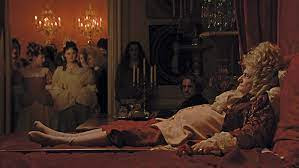 |
| George Marchal, Simone Signoret and Michel Piccoli in Death in the Garden |
Luis Bunuel's
Death in the Garden, from 1956, is a melodramatic adventure film that shows Bunuel could be a competent commercial director when he chose (or needed) to be. Based on Jose-Andre Lacour's novel, the film is set in an unnamed South American country where the authorities have nationalized the country's mines. The miners, mostly French expatriates, revolt against this perceived injustice and, when the rebellion is crushed, a disparate band of survivors try to escape through the jungles to the safe haven of Brazil.
The film was a French Mexican co-production, shot in Mexico with a Mexican crew and a French speaking cast. The male lead is Georges Marchal, a notable French leading man of the 50s, who, at the time, was primarily appearing in swashbucklers or sword and sandal epics. He physically resembles Sterling Hayden, though he lacks Hayden's manly burr. His character, Chark, is a rogue and a bounder who is introduced giving the middle finger to the Federales. His character is akin to many rebellious and cynical French protagonists of the era (the sons of Bogart and James M. Cain), a no-nonsense adventurer looking out for number one; much like Yves Montand's "Mario" in 1953's The Wages of Fear. a film whose success spurred on the making of the similar Death in the Garden.
Marchal is suitably insolent and jousts well with the female lead, Simone Signoret. At the height of her fame and beauty, Signoret is well cast as a hooker with a heart of lead. Reportedly pining for husband Montand, Signoret was not thrilled with the location shooting. Bunuel lets her have a few glam moments, but seems eager to cake Signoret with mud, blood, ooze and mire as she treks through the jungle. Civilization is a materialist fantasy in Death in the Garden, as in all of Bunuel's work.
Michel Piccoli, who like Marchal would appear in future Bunuel features, is cast as a missionary. Predictably, for a Bunuel film, the cleric is a craven hypocrite who has even less of a moral compass than Chark. Piccoli, expert at portraying dispassionate and hollow men, is a constant source of jaundiced amusement.
The setting and color photography draws comparison to Bunuel's earlier Robinson Crusoe, somewhat to Death in the Garden's detriment. The source material is not as strong as Defoe's classic. Still, even though it is minor Bunuel, Death in the Garden is worth a gander for both Bunuel buffs and the casual viewer. As a chunk of entertainment, Death in the Garden delivers. The film's surrealistic asides, particularly a large snake carcass being devoured by ants, show that Bunuel was doing more than passing time and making a buck.



































